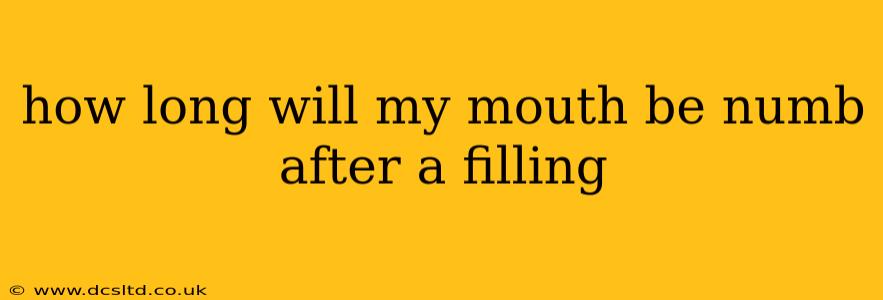How Long Will My Mouth Be Numb After a Filling?
Getting a dental filling is a common procedure, but the lingering numbness afterward can be a concern. The duration of numbness depends on several factors, and understanding these can help manage expectations and alleviate any anxiety. This comprehensive guide will explore the typical timeframe, influencing factors, and what to do if the numbness persists.
What Causes the Numbness?
Before diving into the duration, let's understand why your mouth becomes numb. Your dentist uses a local anesthetic, typically lidocaine or similar, to numb the area before the procedure. This anesthetic temporarily blocks nerve signals, preventing you from feeling pain during the filling process. The numbness is a direct result of this anesthetic's action on your nerves.
How Long Does the Numbness Typically Last?
The typical duration of numbness after a dental filling ranges from one to three hours. However, this is just an average. Some individuals might experience numbness for a shorter period, while others might feel it for a little longer. Several factors influence this duration, as we'll explore below.
Factors Affecting the Duration of Numbness:
Several factors can influence how long the numbness lasts:
- Type and Amount of Anesthetic: The type of anesthetic used and the amount injected directly impact the duration of numbness. Stronger anesthetics or larger doses can lead to longer-lasting effects.
- Individual Metabolism: How quickly your body metabolizes the anesthetic plays a significant role. Faster metabolism generally means quicker dissipation of the anesthetic and shorter numbness.
- Injection Site and Technique: The precision of the injection and the location where the anesthetic is administered also affect the duration.
- Underlying Health Conditions: Certain medical conditions might influence how your body processes the anesthetic, potentially prolonging the numbness.
- Type of Filling: While the type of filling itself doesn't directly affect the numbness, a more complex procedure might require more anesthetic and thus potentially longer numbness.
What if the Numbness Lasts Longer Than Expected?
While most cases resolve within a few hours, if your numbness persists for more than 24 hours, it's crucial to contact your dentist. Prolonged numbness could indicate a problem, and seeking professional advice is essential.
What Can I Do While My Mouth is Numb?
During the period of numbness, it's vital to take precautions:
- Avoid Hot or Cold Foods: Your numb area has reduced sensation, increasing the risk of burns or cold damage.
- Be Mindful of Chewing: Accidental biting of your cheek or tongue is possible. Eat soft foods and chew carefully on the opposite side.
- Avoid Alcohol: Alcohol can interact with some anesthetics, potentially prolonging the effects or causing other issues.
Is it Normal to Experience Some Tingling or Discomfort Afterward?
Yes, some tingling or mild discomfort is normal as the numbness wears off. This is your body's nervous system returning to its normal function. However, persistent or severe pain warrants contacting your dentist.
Can I Drive After a Filling with Local Anesthetic?
This is a critical question. Driving while still significantly numb is generally not recommended. Reduced sensation can impair your ability to react quickly and safely. It's best to wait until the numbness has completely subsided before driving.
In Conclusion:
While the typical duration of numbness after a dental filling is one to three hours, several individual factors can influence this timeframe. Remembering to contact your dentist if numbness persists beyond 24 hours and taking appropriate precautions while numb is crucial for your safety and well-being. By understanding these factors and taking the necessary precautions, you can comfortably navigate the post-filling period.
